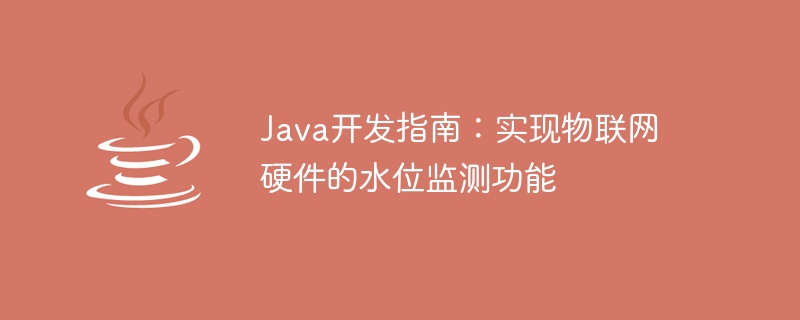Home >Java >javaTutorial >Java Development Guide: Implementing the Water Level Monitoring Function of IoT Hardware
Java Development Guide: Implementing the Water Level Monitoring Function of IoT Hardware
- PHPzOriginal
- 2023-09-21 15:12:111220browse

Java Development Guide: To implement the water level monitoring function of IoT hardware, specific code examples are required
The Internet of Things is a field that has developed rapidly in recent years. It will integrate various devices and sensors are connected through the Internet to achieve intelligent and automated control and monitoring. In IoT applications, water level monitoring is a common and important function that can be used in various scenarios, such as reservoir water level monitoring, pool water level monitoring, etc. This article will introduce how to use Java to develop and implement the water level monitoring function of IoT hardware, and provide specific code examples.
First of all, we need to choose appropriate hardware equipment, such as water level sensors. Water level sensors typically use pressure sensing technology to measure the height of the water level. Choosing the right sensor is key to ensuring monitoring accuracy and stability.
Secondly, we need to build an Internet of Things platform to receive sensor data, process and display it. Common IoT platforms include AWS IoT, IBM Watson IoT, Alibaba Cloud IoT, etc. In this article, we will take the Alibaba Cloud IoT platform as an example to introduce it.
On the Alibaba Cloud IoT platform, we need to create an IoT device to connect to the sensor. For specific operations, please refer to the development documentation of Alibaba Cloud IoT Platform. After creating the device, we will get the product Key of the device and the triplet of the device (ProductKey, DeviceName and DeviceSecret) for subsequent code development.
Then, we can start writing Java code to implement the water level monitoring function. First, we need to introduce the relevant Java development libraries and the SDK of the Alibaba Cloud IoT platform. Specific dependencies can be added in the Maven or Gradle configuration file. Next, we need to authenticate the device and establish a connection with the Alibaba Cloud IoT platform. The code example is as follows:
import com.aliyun.openservices.iot.sdk.*;
import com.aliyun.openservices.iot.sdk.auth.*;
import com.aliyun.openservices.iot.sdk.connection.*;
public class WaterLevelMonitor {
public static void main(String[] args) {
// 设置设备的三元组
String productKey = "your_product_key";
String deviceName = "your_device_name";
String deviceSecret = "your_device_secret";
// 创建设备的认证
DeviceCredential deviceCredential = new DeviceCredential(productKey, deviceName, deviceSecret);
// 建立与阿里云物联网平台的连接
DeviceConnectOptions options = new DeviceConnectOptions();
options.setKeepAliveInterval(60);
options.setCleanSession(true);
options.setAutomaticReconnect(true);
options.setDeviceCredential(deviceCredential);
DeviceConnection connection = new DeviceConnection(options);
connection.connect();
// 实现水位监测功能
// TODO: 添加具体的水位监测逻辑
// 关闭与阿里云物联网平台的连接
connection.disconnect();
}
}In the code example, we create the authentication of the device by setting the triplet of the device, and use the authentication information to establish a connection with the Alibaba Cloud IoT platform. Then, we can add specific water level monitoring logic in the TODO comment, such as reading sensor data, uploading data to the Internet of Things platform, etc. Finally, we close the connection to the IoT platform before the end of the program.
It should be noted that the specific water level monitoring logic needs to be written according to the sensors and hardware devices used. You can refer to the sensor manual and hardware device documentation for development. At the same time, you also need to refer to the development documentation of the Alibaba Cloud IoT platform to learn how to read sensor data and upload it to the IoT platform.
To summarize, this article introduces how to use Java to develop and implement the water level monitoring function of IoT hardware, and provides specific code examples. Hope it will be helpful to IoT developers. In the actual development process, adjustments and optimizations need to be made according to specific needs and hardware equipment. I wish you success in your IoT development!
The above is the detailed content of Java Development Guide: Implementing the Water Level Monitoring Function of IoT Hardware. For more information, please follow other related articles on the PHP Chinese website!

